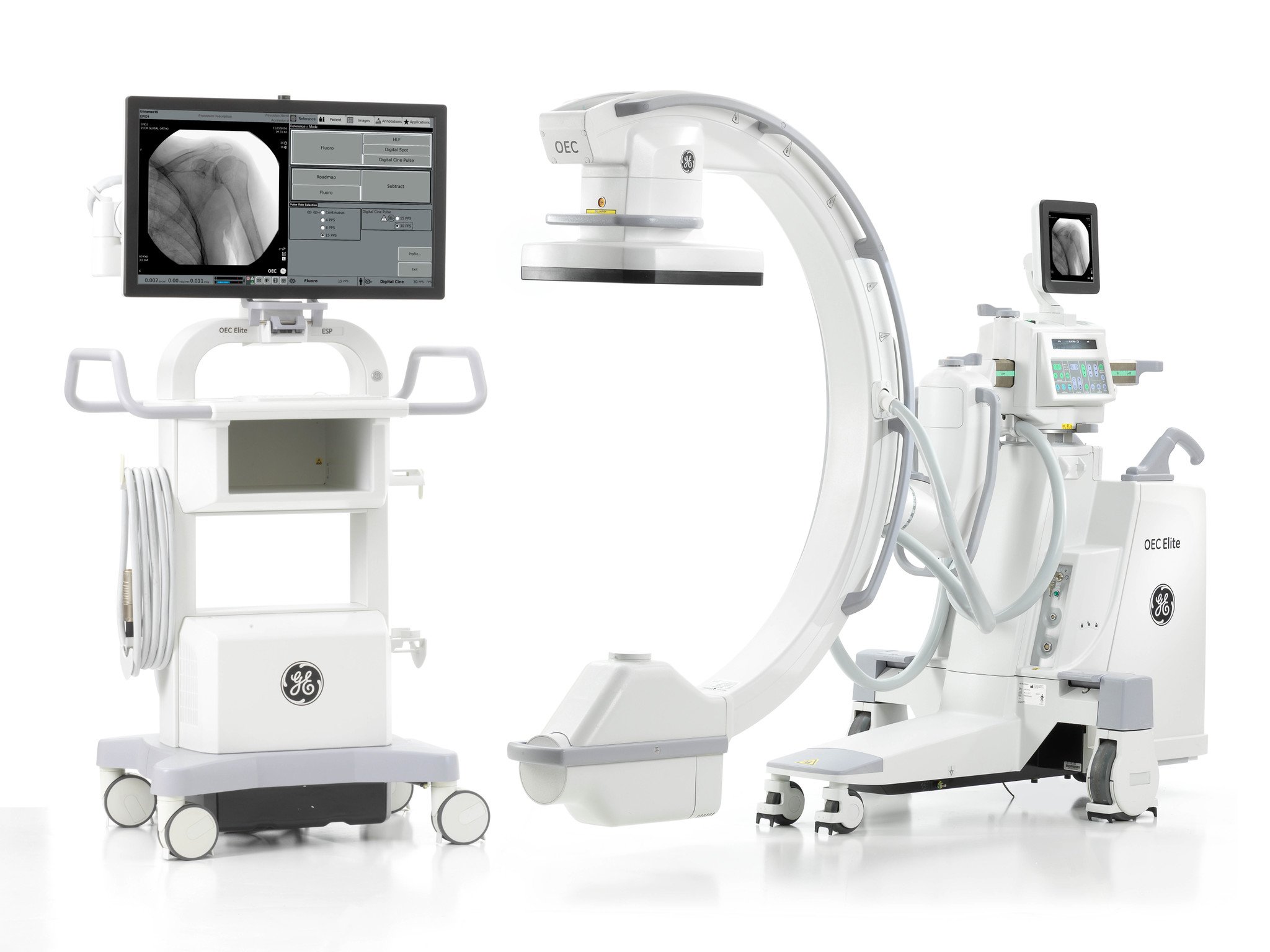
GE Healthcare OEC Elite CFD mobile C-arm with CMOS flat detector
This case study reports on the outcomes achieved with GE Healthcare OEC Elite CFD mobile C-arms with CMOS flat panel detectors (CFD) in a variety of clinical settings by an interventional cardiology endovascular surgeon and an interventionalist specializing in pain management. Those results include good image quality at lower dose and improved workflow efficiency.
Achieving Image Quality Using Lower Dose
The higher signal to noise ratio of the OEC Elite CFD mobile c-arm results in better image quality in low dose conditions. Elias H. Kassab, M.D., an interventional cardiology endovascular surgeon, is using the CFD mobile C-arm for dialysis declots and access, (declot under X-ray guidance), patients with thrombosed or clotted dialysis fistulas, stenting in the peripheral arteries, and atherectomies. “The OEC Elite CFD is very highly recommended, in terms of the C-arm that provides an excellent outcome and will deliver the job, at the lowest radiation exposure … Radiation exposure has been significantly lessened vis-a-vis other C-arms.”
Jonathan Sobocinski, M.D., Ph.D., Vascular Surgeon, Hospital University Center in Lille, France, explained the benefits of an OEC Elite CFD for his endovascular interventions: “There are several benefits of using the new flat panel detector system. For example, lower radiation exposure and lower concentration of contrast media during injection. Now we only work with diluted contrast injections.”
Live Zoom Offers More Precise Visualization
The Live Zoom feature of the OEC Elite CFD mobile C-arm allows images to be enlarged with flexibility — between 1x to 4x — for both static and cine images. According to Sobocinski, the Live Zoom feature enabled users to easily pan and zoom images or Cine runs and take a fluoro image or Cine run in the selected zoom setting.
“We are indeed big fans of the Live Zoom mode and big monitor display because both tools together alleviate the need to use magnification mode which increases dose,” he stated. “In general, Live Zoom gives the perfect resolution with more precision of the challenging segment of the artery that we want to cross, stent, or visualize with less dose compared to magnification mode. Again, the idea is always to find the best compromise between image quality and radiation dose exposure.”
Detector Displays More Anatomy
Ayman Tarabishy, M.D., is the medical director at Enhance Center for Interventional Spine and Sports and a board-certified pain management specialist. He describes the advantages of the wider field of view with the OEC Elite CFD mobile C-arm.
“A C-arm that limits dose to you and your patients, gives you great image quality, has a large 4K screen, is very responsive, and has a large field of view, are all advantages. The OEC Elite CFD mobile C-arm has a wider field of view for positioning and counting purposes, so you don’t have to take as many pictures, you just take one and you see the T12 to S1 vertebrae. The OEC Elite CFD mobile C-arm gives you more detail and increased ability to pick up those small bone spurs and narrowing structures that might get in your way, so you can plan a clearer path for your needle. Having a large field of view really helps, especially if you are doing a four-level medial branch block. You can see all four levels in the same picture, and you can advance four needles at the same time. You can’t do that if you have to move the C-arm.”
Increased Efficiency with Ease of Use and Positioning
The OEC Elite CFD mobile C-arm has delivered increased efficiency with its easy positioning that makes it easier to position patients. “There has been a big interest in acquiring C-arms that would perform very close to the fixed systems that we interventional physicians, interventional cardiologists, surgeons, and eventually radiologists, have been used to in the hospital,” observed Kassab. “We fell in love with it when we demoed the OEC Elite CFD mobile C-arm. We realized the image quality is excellent, the operability is excellent, and the fluidity of the C-arm — in terms of changing position — is quite easy to use. The roadmapping feature is quite improved, with excellent and very vivid roadmapping enhancement. It is very helpful for patients with carotid angiography; different aneurysmal dilatations of the aortoiliac region; and patients with knee replacements and being able to bend the knees. It is very user friendly. The operability is excellent.”
“Sometimes you have patients who are in severe pain and can’t position themselves,” reported Tarabishy. “The OEC Elite CFD mobile C-arm gives you all the angles you need. I’ve even done procedures on patients in a wheelchair.”
Conclusion
Practitioners from multiple disciplines are using OEC Elite CFD mobile C-arms and experiencing positive results. The CMOS flat detector allows them to see more anatomy and delivers exceptional image quality at lower dose, using software features such as Live Zoom. The enhanced positioning and ease of use are also contributing to increased efficiency by optimizing the clinical workflow.
Disclaimer
The statements made by Elias H. Kassab, M.D., and Ayman Tarabishy, M.D., are their opinions and are based on results achieved in their unique settings. Results may vary, and there is no guarantee that other customers will achieve the same results.
Jonathan Sobocinski, M.D., Ph.D., is a paid consultant for GE Healthcare. The statements by Sobocinski described here are based on his own opinions and on results that were achieved in his unique setting. Since there is no typical hospital and many variables exist, i.e., hospital size, case mix, etc., there can be no guarantee that other customers will achieve the same results.



 April 17, 2024
April 17, 2024 








